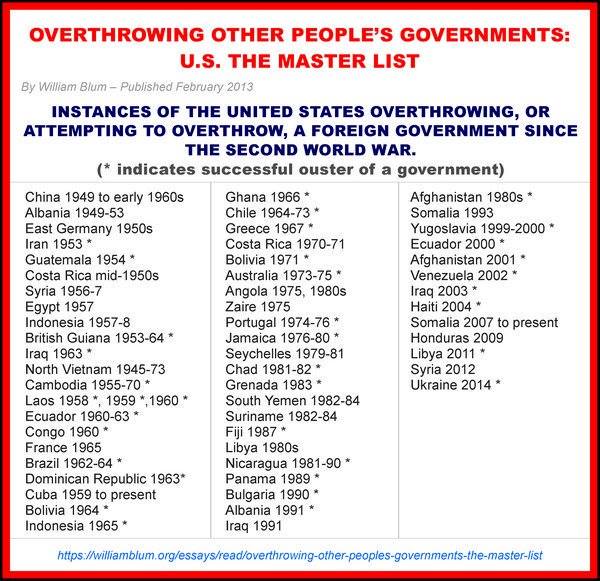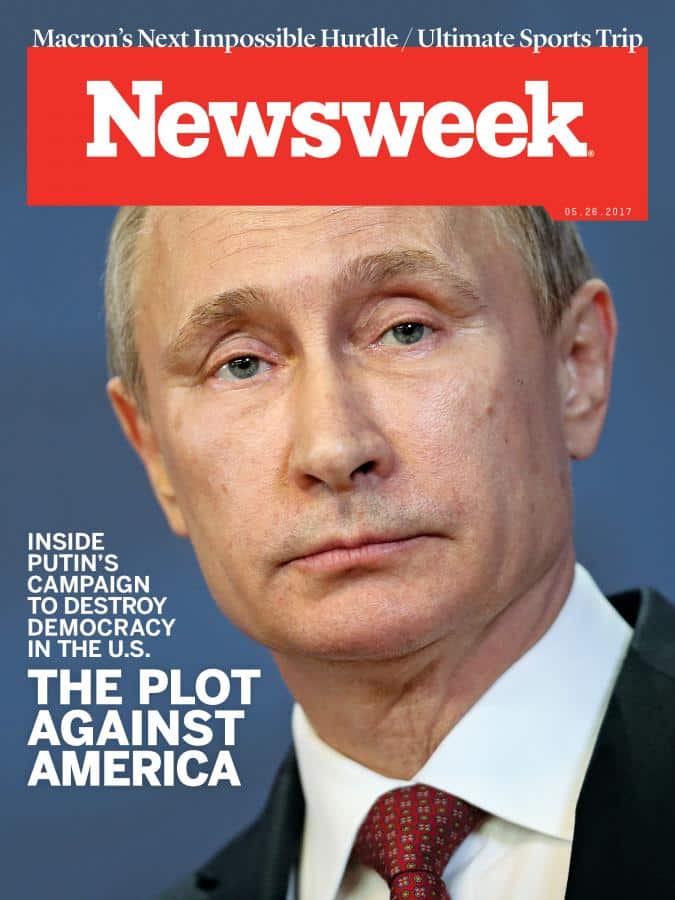Hard reminders: Mutual Assured Destruction means exactly that
Authored by Philip Giraldi via The Strategic Culture Foundation,
Sometimes it is possible to read or view something that completely changes the way one looks at things. I had that experience last week when I read an article at Lobelog entitled “A Plea for Common Sense on Missile Defense,” written by Joe Cirincione, a former staffer on the House Armed Services Committee who now heads the Ploughshares Fund, which is a Washington DC based global foundation that seeks to stop the spread of nuclear, chemical and biological weapons.
The article debunks much of the narrative being put out by the White House and Pentagon regarding missile defense. To be sure, it is perfectly reasonable to mistrust anything that comes out of the federal government justifying war given its track record going back to the War of 1812. And the belligerent posture of the United States towards Iran and North Korea can well be condemned based on its own merits, threatening war where there are either no real interests at stake or where a diplomatic solution has for various reasons been eschewed.
But the real reason why the White House gets away with saber rattling is historical, that the continental United States has not experienced the consequences of war since Pancho Villa invaded in 1916. This is a reality that administration after administration has exploited to do what they want when dealing with foreign nations: whatever happens “over there” will stay “over there.”
Americans consequently do not know war except as something that happens elsewhere and to foreigners, requiring only that the U.S. step in on occasion and bail things out, or screw things up depending on one’s point of view. This is why hawks like John McCain, while receiving a “Liberty” award from Joe Biden, can, with a straight face, get away with denouncing those Americans who have become tired of playing at being the world’s policeman. He describes them as fearful of “the world we have organized and led for three-quarters of a century, [abandoning] the ideals we have advanced around the globe, [refusing] the obligations of international leadership and our duty to remain ‘the last best hope of earth’ for the sake of some half-baked, spurious nationalism.”
 McCain’s completely fatuous account of recent world history befits a Navy pilot who was adept at crashing his planes and almost sank his own aircraft carrier. He also made propaganda radio broadcasts for the North Vietnamese after he was captured. The McCain globalist-American Exceptionalism narrative is also, unfortunately, echoed by the media. The steady ingestion of lies and half-truths is why the public puts up with unending demands for increased defense spending, accepting that the world outside is a dangerous place that must be kept in line by force majeure. Yes, we are the good guys.
McCain’s completely fatuous account of recent world history befits a Navy pilot who was adept at crashing his planes and almost sank his own aircraft carrier. He also made propaganda radio broadcasts for the North Vietnamese after he was captured. The McCain globalist-American Exceptionalism narrative is also, unfortunately, echoed by the media. The steady ingestion of lies and half-truths is why the public puts up with unending demands for increased defense spending, accepting that the world outside is a dangerous place that must be kept in line by force majeure. Yes, we are the good guys.
But underlying the citizenry’s willingness to accept that the military establishment should encircle the globe with foreign bases to keep the world “safe” is the assumption that the 48 States are invulnerable, isolated by broad oceans and friendly nations to the north and south. And protected from far distant threats by technology, interceptor systems developed and maintained at enormous expense to intercept and shoot down incoming ballistic missiles launched by enemies overseas.
In a recent speech, relating to the North Korean threat, President Donald Trump boasted that the United States anti-missile defenses are 97% effective, meaning that they can intercept and destroy incoming projectiles 97 times out of a 100. Trump was seeking to assure the public that whatever happens over in Korea, it cannot have an undesirable outcome over here in the continental United States nor, apparently, in Hawaii, Alaska and overseas possessions like Guam, all of which are shielded under the anti-missile defense umbrella. Trump was undoubtedly referring to, even if he was ignorant of many of the specifics, the Ground Based Midcourse Defense (GMD) installations in Alaska and Hawaii, which are part of the existing $330 billion missile defense system.
It is certainly comforting to learn that the United States cannot be physically attacked with either nuclear or conventional weapons no matter what our government does overseas, but is it true? What if the countermeasures were somewhat closer to 0% effective? Would that change the thinking about going to war in Korea? Or about confronting Russia in Eastern Europe? And for those who think that a nuclear exchange is unthinkable it would be wise to consider the recent comments by Jack Keane of the aptly named Institute for the Study of War, a leading neoconservative former general who reportedly has the ear of the White House and reflects its thinking on the matter. Keane is not hesitant to employ the military option against Pyongyang and he describes a likely trigger for a U.S. attack to take out its nuclear facilities or remove “leadership targets” as the setting up of a ballistic missile in North Korea with a nuclear warhead mounted on top “aimed at America.” Some observers believe that North Korea is close to having the ability to reduce the size of its nukes to make that possible and, if Keane is to be believed, it would be considered an “act of war” which would trigger an immediate attack by Washington. And a counter attack by Pyongyang.
The claim of 97% reliability for the U.S.’s anti-missile defenses is being challenged by Cirincione and others, who argue that the United States can only “shoot down some…missiles some of the time.” They make a number of arguments that are quite convincing, even to a layman who has no understanding of the physics involved. I will try to keep it simple.
First of all, an anti-missile interceptor must hit its target head on or nearly so and it must either actually strike the target or explode its own warhead at a close enough distance to be effective. Both objectives are difficult to achieve. An Intercontinental Ballistic Missile (ICBM) travels at 5,000 meters per second. By way of comparison a bullet fired from a rifle travels at about one fifth that speed. Imagine two men with rifles standing a mile apart and firing their weapons in an attempt to have the bullets meet head on. Multiply the speed by five if one is referring to missiles, not bullets. Even using the finest radars and sensors as well as the most advanced guidance technologies, the variables involved make it much more likely that there will be a miss than a hit. Cirincione observes that “…the only way to hit a bullet is if the bullet cooperates.”
A new by the U.N. Special Rapporteur on extreme poverty and human rights in the United States finds about 40 million...
Second, the tests carried out by the Pentagon to determine reliability are essentially fraudulent. Contrary to the Donald Trump comment, the 97% accuracy is an extrapolation based on firing four anti-missile missiles at a target to make up for the fact that in the rigged tests a single interceptor has proven to be closer to only 56% accurate, and that under ideal conditions. This statistic is based on the actual tests performed since 1999 in which interceptors were able to shoot down 10 of 18 targets. The conclusion that four would result in 97% derives from the assumption that multiple interceptors increases the accuracy but most engineers would argue that if one missile cannot hit the target for any number of technical shortcomings it is equally likely that all four will miss for the same reason.
The tests themselves are carefully scripted to guarantee success. They take place in daylight, preferably at dusk to ensure maximum visibility, under good weather conditions, and without any attempt made by the approaching missile to confuse the interceptor through the use of electronic countermeasures or through the ejection of chaff or jammers, which would certainly be deployed. The targets in tests have sometimes been heated to make them easier to find and some have had transponders attached to make them almost impossible to miss. As a result, the missile interceptor system has never been tested under realistic battlefield conditions.
Even the federal government watchdog agencies have concluded that the missile interception system seldom performs. The Government Accountability Office concluded that flaws in the technology, which it describes as “failure modes,” mean that America has an “interceptor fleet that may not work as intended, prompting one Californian congressman John Garamendi to observe that “I think the answer is absolutely clear. It will not work. Nevertheless, the momentum of the fear…of the investments…[of] the momentum of the industry, it carries forward.”
The Operational Test and Evaluation Office of the Department of Defense has also been skeptical, reporting that the GMD in Alaska and Hawaii has only “…a limited capability to defend the U.S. Homeland from small numbers of simple intermediate range or intercontinental ballistic missile threats launched from North Korea…the reliability and availability of the operational [interceptors] are low.”
The dangerous overconfidence being demonstrated by the White House over the ability to intercept a North Korean missile attack might indeed be in some part a bluff, designed to convince Pyongyang that it if initiates a shooting war it will be destroyed while the U.S. remains untouched. But somehow, with a president who doesn’t do subtle very well, I would doubt that to be the case. And the North Koreans, able to build a nuclear weapon and an ICBM, would surely understand the flaws in missile defense as well as anyone.
But the real danger is that it is the American people that is being fooled by the Administration. War is thinkable, even nuclear war, if one cannot be touched by it, a truism that has enabled the sixteen-year- long and counting “global war on terror.” If that is the message being sent by the White House, it would encourage further reckless adventurism on the part of the national security state. Far better to take the North Korean threat seriously and admit that a west coast city like Seattle could well become the target of a successful nuclear weapon attack.
That would demonstrate that war has real life consequences and the unfamiliar dose of honesty would perhaps result in a public demand to seriously negotiate with Pyongyang instead of hurling threats in speeches at the United Nations and on Capitol Hill.
[premium_newsticker id="211406"]
 Philip Giraldi (born c. 1946) is a former counter-terrorism specialist and military intelligence officer of the United States Central Intelligence Agency (CIA) and a columnist and television commentator who is the Executive Director of the Council for the National Interest.
Philip Giraldi (born c. 1946) is a former counter-terrorism specialist and military intelligence officer of the United States Central Intelligence Agency (CIA) and a columnist and television commentator who is the Executive Director of the Council for the National Interest. 
This work is licensed under a Creative Commons Attribution-NonCommercial 4.0 International License
All image captions, pull quotes, appendices, etc. by the editors not the authors.


















Peter VE said...
Putin doesn't need secret agents when the West puts in its stooges: they have decisively demonstrated how to ruin a country by following the siren call of Westernization.
Veronica said...
Slo Mo said...